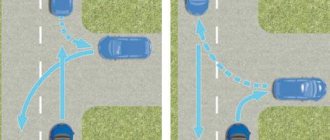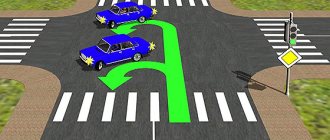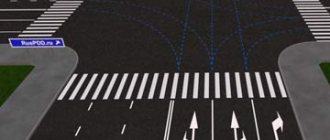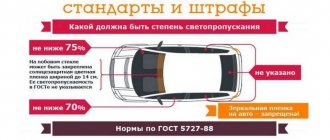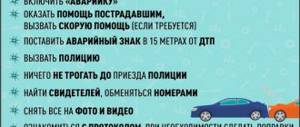Despite the fact that the traffic rules clearly indicate how a motorist should act on public highways, many drivers interpret these rules in their own way. This leads to an increase in the number of accidents on the roads. One of the controversial issues that often arise when changing lanes is the so-called “right-hand rule.”
You need to understand that this rule applies only when certain conditions arise.
In particular, it needs to be followed at unregulated intersections and in places where the traffic order is not stipulated by the current rules.
But what is interference on the right? How should drivers change lanes based on this rule?
What is interference on the right?
Answering the question of what is an obstacle on the right, it can be noted that all drivers without exception know the “right hand” rule. People turn to him for help in a large number of different situations.
Here are the most basic traffic rules: obstacle on the right:
- When crossing an unregulated intersection of roads of equal status.
- When driving around in parking lots and at gas stations.
- In the process of changing lanes, cars moving in the same direction, but on different lanes of the road.
In this article you can recall the driving school and the features of the “interference on the right” rule. You can find out what it is and in what situations it can be used.
It’s worth noting right away that the traffic rules completely lack such generally accepted terms among drivers as “right-hand rule” and “interference on the right at an intersection.”
In fact, these are, at a conditional level, simplified expressions of clause 8.9 of the Russian Traffic Regulations. Its essence lies in the fact that the rules cannot specifically regulate all situations that arise on the road regarding who is given priority on the highway.
If the driving sequence was not provided for by the Road Traffic Rules, drivers must pass each other, allowing the driver “interfering” on the right side to pass. Only then will you need to continue moving.
In other words, if along the route a person crosses the path of another vehicle, and if the general order of movement is not stipulated by the traffic rules, he must give way to this car if the car is on the right at the time of crossing.
Priority signs include such indicators as “Main road”, “Intersection with an additional road”, “Give way”, “Driving without stopping is prohibited”, “Take advantage of oncoming traffic”.
The equivalent intersection deserves special attention . This is the usual intersection of routes with equal coverage, as well as those characterized by equal priority.
If there are no priority signs listed above, the “right hand” rule automatically begins to apply between drivers. In this case, the intersection at the automatic level becomes equivalent.
If an obstacle appears to the right of the driver, he gives way; if a car is seen on the left, he is obliged to give way.
The opponent must also act according to this rule. If he encounters an obstacle on the right, he must provide the driver next to him with the right of way.
Thus, if on the highway the priority of movement is not determined by signs, traffic lights and traffic controllers, the “interference on the right in the yard” from the leading driver should receive priority in movement.
If emergency situations arise when this rule is violated, there may be three reasons for this. The person at fault for the accident is not very familiar with the traffic rules. Such drivers believe that since at the last intersection he was driving on the main road, then the situation will repeat in this situation.
In reality, this is not the case, which is why the emergency situation arises. Also, the culprit of the accident may believe that in the process of leaving the dirt road, everyone must let him pass, including those moving on the left.
If driving onto asphalt, the driver must give way to everyone, since the dirt road is in all cases a secondary route . This rule applies to leaving stadiums, parking lots and other similar areas.
Often an emergency situation arises between traffic participants, which arose on the basis that the driver considered that he was not obliged to let the driver pass on the right side for the reason that he was turning left. Rotating in this case does not change anything.
Video: “Behind the wheel.” Traffic rules: obstacle on the right
When the road narrows
Another situation in which you need to apply traffic rules when there is an obstacle on the right is a narrowing of the road. In general, the procedure is fully described in the traffic rules, paragraph 8.9, according to which it is required, following the rules for changing lanes from the previous paragraph, to give priority to vehicles moving in the same direction. Thus, you will again have to pass the interference on the right until you have the opportunity to change lanes without causing interference. So you need to prepare for a narrowing of the road as early as possible.
Features of applying the “interference from the right” rule
The principle of movement described above belongs to the category of universal ones, but you need to clearly know the boundaries of its use. The “right hand” rule, like all other rules, has three mandatory conditions when the rule applies.
They can solve the question of how to determine the interference on the right:
- The trajectories of vehicles must necessarily intersect. In this case, the cars will not interfere with each other and will be able to move safely in the prescribed directions.
- The rule applies to equal participants. None of the participants in the disputable situation, who necessarily strives to pass first, should have a certain status advantageous position equivalent to other participants in the movement. In this case, the principle of the right-hand rule cannot be used in such relationships as vehicle-pedestrian, tram and ordinary car. In this case, the pedestrian and the tram are a participant in the road traffic.
- The general order of travel is not specified by traffic rules. In other words, if this particular rule is planned to be used, traffic rules should not be provided.
Here are some examples of these rules. If a driver leaves the parking lot at the same time as another car, this situation does not have a clear traffic rule . In this case, you must give way to the driver driving on the right, who is an obstacle on the right.
We can consider another case with the simultaneous rearrangement of cars of equal mobility. If a motorcycle is involved in a situation that does not have a right-hand obstacle in the form of a passenger car, it will change lanes first.
As for the driver of a passenger car, he will be the right obstacle for the motorcyclist, and accordingly will be obliged to give way to him.
Applying the rule when changing lanes
Rebuildings can be divided into 2 groups:
- Simple (only one vehicle is rebuilt);
- Complex or mutual, the name speaks for itself; in this case, a simultaneous reconstruction of the vehicle occurs.
When simply rearranging questions, no rule always dictates that you give way to the participant who changes something. And here the one who is rebuilding gives way. But with simultaneous (mutual) restructuring, the order is determined by applying the rule of interference from the right.
In what cases does “interference from the right” not work?
It is also worth considering the conditions when the concept of “interference on the right” is not relevant, for example, whether the interference rule applies in a parking lot in 2021.
This question was discussed above from the point of view of applying the rule, and here as an answer to the question in which cases it does not apply.
Here are a few situations worthy of attention:
- Inconsistency of status of traffic participants. The term “interference on the right” will be irrelevant if initially the participants in the movement were of unequal status. This may be the current controversial situation between a car and a pedestrian, as well as the situation with trackless vehicles and trams.
- Inequality of priority positions of participants, regulated by road signs, traffic lights and traffic controllers.
The second point is worth considering in more detail using examples . If one driver is on a main road and the other is driving on a secondary road, they will be able to apply the right-hand rule between them. Here, the person driving along the main highway will have priority.
If one driver is moving along the road, and the second is leaving a gas station or a residential yard, the controversial situation regarding the yield of the road cannot be resolved according to the “interference on the right” rule.
According to traffic rules, a person who leaves the adjacent territory is obliged to give way to everyone.
It is worth considering one more situation . One driver moves under a green traffic light, and the driver next to him moves along an additional section of the traffic light.
The initial positions of the two drivers are equivalent, since a person driving onto a nearby additional section with the main prohibiting traffic signal is obliged to let ahead of all those driving to the main permissive traffic light.
There are other situations when the described rule does not “work” . For example, when starting to drive or when reversing, you must first give way to other drivers.
Driving on uneven roads
Paragraph 13.10 of the traffic rules talks about the standards for passing unequal intersections. This rule states that when the main road at an intersection changes direction, drivers traveling along the main road are guided by the rules for crossing intersections of equivalent roads. The same standards apply to drivers driving on secondary roads.
If the main road changes direction, then traffic is regulated by the “Interference on the right” rule. The same rule applies to traffic if the following signs are installed: “Main road”, “Driving without stopping is prohibited”, “Give way”.
"Interference on the right" at intersections
The “right hand” rule can also be applied when moving through intersections.
Despite the fact that the traffic rules in section 13 regulate certain rules for driving through intersections, the process, if desired, can be seriously simplified by using the most universal right-hand rule.
This principle can be formulated as follows: given equal opportunities, drivers should pass other vehicles using the “right hand” rule.
Difficulties in using this rule applied at intersections are usually accompanied by some dynamism of road events.
When moving through an intersection, you need to remember situations when applying the “right hand” rule is strongly discouraged.
These are situations with the most clear regulation of a well-structured sequence of movements. Here are the most basic of them :
- "dispute" with a tram . The rail vehicle must pass first because it has priority based on the category of the urban vehicle itself. The rule of interference on the right is not relevant for trams. Trams have priority in all situations;
- initial disparity of positions . If drivers are on the highway in directions of different priority, that is, someone is driving on the main one, and someone on the secondary one, their relationship will not be resolved using the “interference from the right” principle.
This also includes the situation when movement is carried out along an additional section of a traffic light . This situation extends to the main prohibit signal.
Important Tips
People moving along an additional route or leaving a residential yard must give way to everyone.
It is advisable to first establish visual interaction with the driver moving on the left side.
In this case, it will be clear what his subsequent manipulations will be. This is not a special universal rule, it is simply a way to show drivers your intention.
If the driver does not react at all, if the speed of his car does not decrease, you must definitely let him pass.
Particularly unbalanced drivers try to teach such stubborn people a lesson and drive directly. You shouldn't do that. This will lead to an emergency. You shouldn’t waste your nerves, time and health trying to prove something.


